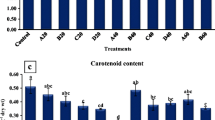Abstract
Field experiment was conducted to assess the effect of treated sewage water on physiological attributes, productivity, micronutrient and heavy metal content in pearl millet (Pennisetum glaucum L.) under different nutrient sources during 2018 and 2019. The experiment consisted of 16 treatment combinations with two irrigation sources [canal and treated sewage water], two levels of farm yard manure [2.5 and 5 t ha−1] that assisted in main plots and four fertility levels [control, 50, 75 and 100% recommended dose of fertilizer (RDF, 156.25 kg N and 62.5 kg P2O5 ha−1)] that assisted in subplots in split-plot design using three replications. The results revealed that the irrigation sources did not influence significantly growth parameters, protein percent, fat acidity, canopy temperature and grain yield. However, canal and treated sewage water differ significantly in respect of photosynthesis and chlorophyll content. Further, data showed that different fertility levels differed significantly (P ≤ 0.05). Higher leaf water potential, canopy temperature, photosynthesis and chlorophyll content were recorded with the application of 100% RDF over control, 50 and 75% RDF. The concentration of heavy metals (Pb, Cd, Ni and Co) decreased with increasing levels of FYM application from 2.5 to 5 tha−1 in plant, while in soils these were increased with increasing levels of FYM application. The interaction effect showed significant effect on pooled grain yield of pearl millet. Application of 100% RDF along with FYM @ 5.0 t/ha produced higher yield over 75% RDF + FYM @ 5.0 tha−1 and 50% RDF + FYM @ 5.0 tha−1 irrespective of irrigation sources. This clearly showed that higher application of FYM reduces the heavy metal accumulation in pearl millet irrigated with treated sewage water.







Similar content being viewed by others
Abbreviations
- FYM:
-
Farm yard manure
- RDF:
-
Recommended dose of fertilizers
- N:
-
Nitrogen
- Cd:
-
Cadmium
- Pb:
-
Lead
- LWP:
-
Leaf water potential
- CTD:
-
Canopy temperature depression
- CEC:
-
Cation exchange capacity
References
AACC International (1999) Approved methods of Analysis, Method 02-03A, fat acidity-rapid method for corn. AACC International, St. Paul, MN
Alamgir M, Kibria MG, Islam M (2011) Effects of farm yard manure on cadmium and lead accumulation in Amaranth (Amaranthusoleracea L.). J Soil Sci Environ Manag 2(8):237–240
Anonymous (2019) Department of Agriculture Cooperation and Farmer Welfare.www.agricrop.nic.in
AOAC (1990) Official methods of analysis. Association of Official Analytical Chemists, Washington, D.C
Bichai F, Polo-Lopez MI, Ibanez PF (2012) Solar disinfection of wastewater to reduce contamination of lettuce crops by Escherichia coli in reclaimed water irrigation. Water Resour 46:6040–6050
Brar MS, Mahli SS, Singh AP, Arora CL, Gill KS (2000) Sewer water irrigation effects on some potentially toxic trace elements in soil and potato plants in north western India. Can J Soil Sci 80:465–471
Gupta AP, Narwal RP, Antil RS (1998) Sewer water composition and its effect on soil properties. Bio-resource Ethnol 65:171–173
Khairwal IS, Yadav OP (2005) Pearl millet (Pennisetum glaucum) improvements in India-retrospect and prospects. Ind J Agric Sci 75(4):183–191
Kibria MG, Osman KT, Ahammad MJ, Alamgir M (2011) Effects of farm yard manure and lime on cadmium uptake by rice grown in two contaminated soils of Chittagong. J Agric Sci Technol 5(3):352–358
Lindsay WL, Norvell WA (1978) Development of a DTPA soil test for zinc, iron, manganese and copper. Soil Sci Soc Am J 42:421–428
Marinho LEO, Tonetti AL, Stefanutti R, Coraucci FB (2013) Application of reclaimed wastewater in the irrigation of rosebushes. Water Air Soil Pollution. 224:1669
Moazzam AK, Shahid SS, Shahzad A, Hamda A (2012) Growth and yield responses of pearl millet (Pennisetum glaucum) irrigated with treated effluent from waste stabilization ponds. Pak J Bot 44(3):905–910
Nath K, Singh D, Shyam S, Sharma YK (2009) Phytotoxic effects of chromium and tannery effluent on growth and metabolism of Phaseolus mungo Roxb. J Environ Bio 30:227–234
Parmar JK, Bhanvadia AS, Ramani VP, Rathod S (2017) Effect of treated dairy effluent water on yield, nutrient content and uptake by Castor-Sorghum Sequence. Nat Environ Pollut Technol. 16:279–286
Sharma KD, Kumar A (2014) Identification of physiological and yield related traits of wheat (Triticum aestivum L) under varying soil moisture stress. J Agromet. 16(1):78–84
Sheoran OP, Tonk DS, Kaushik LS, Hasija RC, Pannu RS (1998) Statistical Software Package for Agricultural Research Workers. Recent advances in information theory, statistics and computer application by DS Hooda and RC Hasija, Department of mathematics statistics, CCS HAU, Hisar
Yadav OP, Bidinger FR (2008) Dual-purpose landraces of pearl millet (Pennisetum glaucum) as sources of high stover and grain yield for arid zone environments. Plant Genet Resour. 6(2):73–78
Yadav RK, Goyal B, Sharma RK, Dubey SK, Minhas PS (2002) Post-irrigation impact of domestic sewage effluent on composition of soils, crops and ground water- A case study. Environ Int 28(6):481–486
Yassen AA, Nadia BM, Zaghloul MS (2007) Role of some organic residues as tools for reducing heavy metals hazards in plant. W. J. Agri. Sci. 3(2):204–207
Acknowledgement
The authors would like to thank CCS HAU, Hisar, Haryana, for providing all the necessary help for conducting the above experiment.
Author information
Authors and Affiliations
Corresponding author
Supplementary information
Below is the link to the electronic supplementary material.
Rights and permissions
About this article
Cite this article
Kumar, P., Kumar, R., Sewhag, M. et al. Physiological attributes, productivity, micronutrient and heavy metal content in pearl millet (Pennisetum glaucum L.) as influenced by treated sewage and canal irrigation water under different nutrient sources. CEREAL RESEARCH COMMUNICATIONS 49, 393–399 (2021). https://doi.org/10.1007/s42976-020-00127-9
Received:
Accepted:
Published:
Issue Date:
DOI: https://doi.org/10.1007/s42976-020-00127-9




